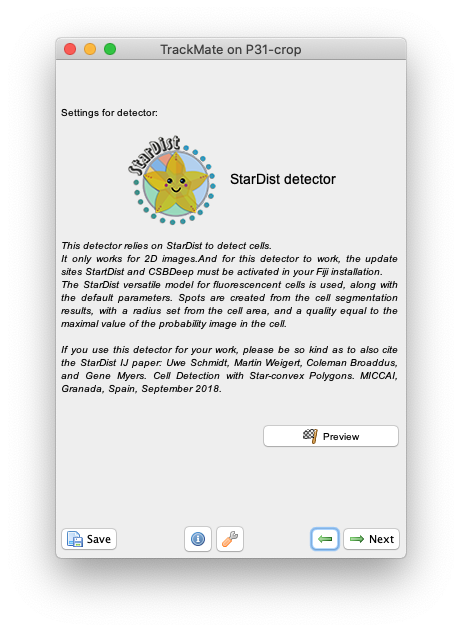
Tracking droplets fusion in microfluidic chamber with #TrackMate, a short thread.
Yesterday I got to discuss with Liridon Aliti (on forum.image.sc) about detecting droplet fusion events in movies like this one:
1/
Yesterday I got to discuss with Liridon Aliti (on forum.image.sc) about detecting droplet fusion events in movies like this one:
1/
We tried to do it in TrackMate, it was fun and I would like to share how we did it. It serves as a demo of the new TrackMate capabilities, but was done in <10min per movie, so it should not be considered a thorough analysis (we only tried one detector one tracker).
2/
2/
The droplet are border objects, so using the excellent morphological segmentation in Fiji #MorphoLibJ by @david_legland and @IgnacioArganda seemed like a good idea. Plus the image quality is incredibly good given the fps (2k here)
3/
3/
For it to work with your images, I first loaded the movie as a grayscale image, inverted it (Shift+I) so that the droplet borders are bright over dark background.
4/
4/

Then I ran TrackMate with the MorphoLibJ detector and used these parameters:
You need to have the TrackMate-MorphoLibJ module installed: github.com/tinevez/TrackM…
5/
You need to have the TrackMate-MorphoLibJ module installed: github.com/tinevez/TrackM…
5/

We have to remove the spots that are not corresponding to the droplets. In the spot filtering panel I specified a filter to keep only the smaller spots:
(also added a filter on X to prevent including spots that are ‘cut’ by the right border of the image in the measurements.)
6/
(also added a filter on X to prevent including spots that are ‘cut’ by the right border of the image in the measurements.)
6/

We see that the fusion events happen too quickly to be resolved in the movie, even at the insane speed it is acquired So we won’t be able to resolve them unambiguously. BUT!
If you continue the tracking steps with a classical tracker, such as the Simple LAP tracker:
7/
If you continue the tracking steps with a classical tracker, such as the Simple LAP tracker:
7/

You can build single droplet tracks:
(visu in TrackMate)
8/
(visu in TrackMate)
8/
And we can analyze the area over time of these tracks, still in TrackMate. The results look like this:
9/
9/

I find it amazing.
We can see that the area variable seems to display only discrete values. It really reminds me of molecular motor stepping (except with far less noisy traces).
10/
We can see that the area variable seems to display only discrete values. It really reminds me of molecular motor stepping (except with far less noisy traces).
10/
So we can assume that each atomic increase in area corresponds to a fusion event with the small droplets produces at the pinch of the tube, that have a fixed size.
I tried to annotate the above plot to guide the eye:
11/
I tried to annotate the above plot to guide the eye:
11/

Of course, this is very crude. We would have to look at the volume increase, not the area and then the chamber geometry come into play.
But still.
12/
But still.
12/
We can even note that the duration of small area states are smaller than large ones. Which makes sense: small droplets only exist close to the pinch where there is plenty of opportunity to fuse.
We can see that if correlate the X position to the size:
13/
We can see that if correlate the X position to the size:
13/

But I guess this is an obvious results. Note however again the stepwise pattern also in X.
Fortunately, Liridon also had movies at a faster acquisition rate: 5k fps 😮
/14
Fortunately, Liridon also had movies at a faster acquisition rate: 5k fps 😮
/14
On this one we could use the LAP tracker of #TrackMate, that can be configured to detect fusion or fission events.
15/
15/

Here are the results:
16/
16/
TrackMate can show the 'lineage' of droplets. Here is a somewhat convoluted lineage of a droplet generated with the TrackScheme tool in TrackMate (time runs from top to bottom, fusion are indicated by 2 branches fusing):
17/
17/

And we can still plot the area over time including the fusion events:
(Again, the area might not be strictly additive, the volume is etc.)
18/
(Again, the area might not be strictly additive, the volume is etc.)
18/

Cool no?
This was done very quickly, using TrackMate everytime. A deeper analysis will reveal proper dynamics, but TrackMate served as an exploration tool with which it was very quick to build a working analysis pipeline.
The new TrackMate preprint:
biorxiv.org/content/10.110…
19/
This was done very quickly, using TrackMate everytime. A deeper analysis will reveal proper dynamics, but TrackMate served as an exploration tool with which it was very quick to build a working analysis pipeline.
The new TrackMate preprint:
biorxiv.org/content/10.110…
19/
This is shared with permission from Liridon. The data was generated at DHRTC (Danish Hydrocarbon Research and Technology Centre) in the Technical University of Denmark (DTU).
20/
20/
• • •
Missing some Tweet in this thread? You can try to
force a refresh






